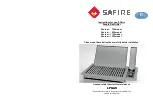
Tool illustration:
Figure 1: Torque adjustment facility
Figure 2:
Bit holder
Figure 3:
Forward / Reverse selector switch
Figure 4:
On/Off switch
Figure 5:
Removable battery pack; press both
clips to take out the battery pack
Important notes:
It is imperative to read these notes before putting
your battery-powered drill/screwdriver into operation:
1.
The removable Ni-Cd battery pack supplied
with your battery-powered drill/screwdriver has
to be charged before you use the tool for the
first time.
2.
Charge the battery pack with the supplied
charger. It takes approx. 6 hours to charge an
empty battery. Never use the supplied charger
to charge any other tools or appliances.
3.
The battery pack reaches its maximum
capacity after approx. five discharge/charge
cycles.
4.
Ni-Cd batteries will also discharge when they
are not in use. It is recommended, therefore, to
charge the batteries regularly.
5.
Please note the data quoted on the rating plate
of the battery charger. Operate the charger
only from the same mains voltage as that
quoted on the rating plate.
6.
In periods of heavy duty the battery pack will
grow warm. Allow the battery pack to cool to
room temperature before starting to charge it.
Safety regulations:
1.
Protect your battery-powered drill/screwdriver
and charger from the damp and rain.
2.
Keep the charger and battery-powered
drill/screwdriver safe from children.
3.
Use only sharp drill bits and undamaged,
properly fitting screwdriver bits.
4.
Wear suitable working clothes and safety
goggles.
5.
Never use the battery-powered drill/screwdriver
and charger in the vicinity of vapours and
combustible liquids.
6.
Look for concealed electric cables, gas pipes
and water pipes before drilling and
screwdriving in walls.
7.
Never throw old batteries into an open fire. Risk
of explosion!
8.
Old and defective batteries do not belong in the
refuse bin. Think of the environment! Cadmium
is toxic. For correct disposal, return old and
defective batteries postage-paid to ISC or
take them to your local old battery depot. Ask
at
your town hall for details of the old battery
depots in your area.
9.
Avoid contact with leaky batteries. Should
contact arise nevertheless, wash the affected
area of skin immediately with soap and water. If
battery acid gets in your eye, rinse the eye with
clear water for at least 10 minutes and consult
a doctor immediately.
10. Protect the charger and its cable from damage
and sharp edges. Damaged cables are to be
replaced immediately by an electrician.
11. Examine your tool for any signs of damage.
Have repairs carried out only by an electrician.
12. Make sure that the contacts of the Ni-Cd
battery pack do not touch other metallic
objects, e.g. nails and screws. Risk of short-
circuiting!
Putting into operation:
Loading the Ni-Cd battery pack
1.
Pull the battery pack out of the handle (Figure
5) by depressing the clips on the side.
2.
Check that your mains voltage is the same as
that quoted on the rating plate. Insert the
charger in a socket-outlet and connect the
charging cable with the charging adapter.
3.
Insert the battery pack in the charging adapter.
The red LED indicates that the battery pack is
being charged. It takes a maximum of 6 hours
to charge an empty battery. The battery pack
may grow warm while it is being charged. This
is normal. Important!
The charger does not
switch off automatically when the battery
pack is fully charged!
If the battery pack fails to become charged, please
check
whether there is voltage at the socket-outlet
whether there is proper contact at the charging
contacts on the charger.
7
GB
AS 12 AlphaTools 11.11.2003 11:59 Uhr Seite 7








































